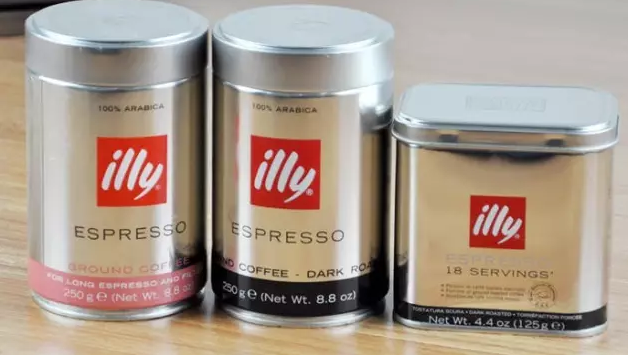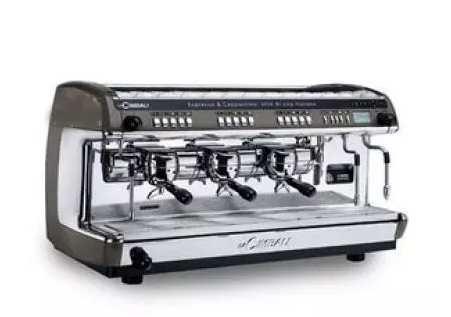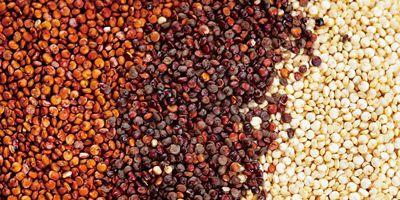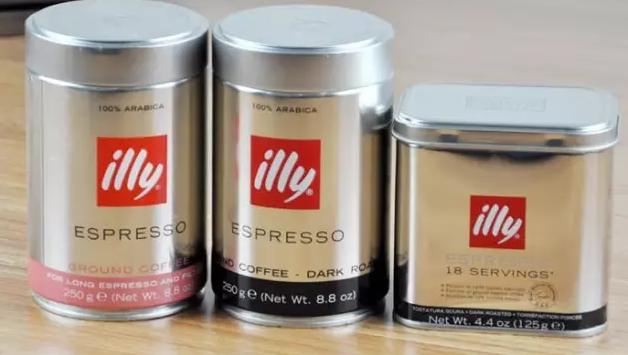The difference between illy and Lavazza, which is better, illy or freshly baked Italian beans?
For professional baristas, please follow the coffee workshop (Wechat official account cafe_style)
Illy
Founded in 1933 in the seaport city of Trieste in northeastern Italy, illy Coffee Company produces more than 11 million kilograms of high-quality coffee beans every year, ranking among the high-quality leaders in the coffee industry.
Admittedly, to a large extent, illy's espersso standards (powder content, pressure, water temperature setting) have had a profound impact on the second wave of coffee culture. Of course, it is respectable to have the ultimate cup of coffee. For most groups, however, they drink coffee in the morning not because they are salivating, but largely because they need a cup of coffee to cheer them up.
What's the difference between red cap, black lid and green lid illy coffee beans?
The baking degree is different. The red lid is a medium-roasted coffee bean with a light bitterness and a heavier sour taste than the black one. The black lid is deep baked beans, focusing on the scorched taste. People who like bitter taste can choose, less sour taste. Green lids are decaf beans.
In China, apart from authorized shops, there are too many shops with illy and lavazza coffee signs, some of which are "selling dog meat with sheep's head", just like being careful when drinking Blue Mountains in China. When you encounter illy and lavazza, you must look carefully, especially illy.
Both Illy and LAVAZZA are very successful brands in the coffee industry, but LAVAZZA takes the civilian route and aims at household consumption, while illy strives to target high-end users and high-end restaurants, regardless of recipe, packaging and marketing. So you say to a foreigner how good LAVAZZA is, they generally disagree, but if illy is good, they generally don't object. In northern Italy, you can often see billboards with illy in coffee shops, but rarely see LAVAZZA.
In terms of taste, both are models of Espresso, and it is not easy to judge, but illy emphasizes 100% Arabica beans and relatively shallow baking, choosing milder and lighter acidity beans, showing obvious sweetness and smooth characteristics. And the taste of LAVAZZA is more in line with the taste requirements of Espresso, its acidity is more balanced, feel "rushing" some, after drinking as mellow as wine, its taste for those who are not used to Espresso, undoubtedly like drinking high wine, but a small glass is endless aftertaste.
Moreover, the domestic boutique baking industry is springing up like bamboo shoots after a spring rain, why do many shopkeepers still choose to import illy coffee beans?
Does inert gas seal really have nothing to worry about?
Although one of illy's greatest inventions is the canning of inert gas, which extends the life cycle of coffee beans. But is inert gas omnipotent?
Take a look at the production date first. if it is right, it will be out of the factory for some time. Some are even 5-9 months old.
Although canned and filled with nitrogen, it reduces volatilization and oxidation. But it is canned in the form of powder after all. Once opened, the oxidation rate is still quite fast, and the longer the opening time, the more flavor attenuation.

Let's find out.
The culprit that destroys the freshness of coffee:
Oxidation: the number one killer of good coffee
Fruit is easily oxidized after it is cut; similarly, coffee is easily oxidized after roasting. When coffee is roasted directly, it produces a large amount of carbon dioxide inside and outside the cell. this carbon dioxide is hidden inside and outside the cell, forming a protective layer, isolating oxygen and slowing down oxidation; however, with the passage of time, this carbon dioxide will gradually lose its function of protecting coffee.
At first, carbon dioxide is released very fast, and it slows down gradually after a few days; after about 10 days, it can release about 50% of carbon dioxide, and after 60 days, it will lose about 90%. The inside of the coffee bean will no longer be able to release carbon dioxide to protect itself.
Because carbon dioxide has the effect of antioxidation, we often see in some media reports that drinking coffee can prevent aging. Although this statement can not be proved, but the effect of drinking coffee can activate thinking has long been recognized by everyone.
It is also mentioned that after the coffee bean is ground, the cell wall will be completely destroyed, and the carbon dioxide will be completely lost within a few minutes, causing the coffee powder to undergo merciless oxidation. Therefore, grind coffee must be drunk as soon as possible! And this is also the reason why selected coffee stores only sell coffee beans and do not buy coffee powder, which is indeed reasonable.
Volatilization: the second killer of good coffee
After roasting, hundreds of new compounds occur inside the coffee beans to form aromas and flavors; some of these compounds are volatile and some are not. Unfortunately, the boiling point of good substances is very low, and these compounds are easily volatile.
Recently, the packaging technology of one-way breathable valve has emerged, which can make the carbon dioxide flow out of the bag without the inflow of oxygen, so it can keep the coffee fresh, which is called "fresh bag". Although its effect is good, the natural decay caused by volatilization can not be resisted.
Hydrolysis: the third killer of good coffee
Baked beans have a moisture content of less than 1%, and their pores are enlarged, making them easy to absorb moisture. Some people even put unused coffee beans in the refrigerator as a deodorant. After absorbing moisture, the interior of the coffee bean will be hydrolyzed.
The hydrolysis of organic compounds is very small, usually through acid or alkali to increase the rate of chemical change, but coffee beans contain a lot of acidic and alkaline substances (caffeine is a kind of alkaloid), so hydrolysis is bound to occur.
Light damage: the fourth killer of good coffee
[light] is the catalytic role of catalysis, which can increase the rate of coffee oxidation and accelerate the deterioration of coffee. In some advanced countries, it can be found that their coffee bags are opaque.
Oil production: the fifth killer of good coffee
After baking at a high temperature, the oil inside the coffee beans will flow to the outlet of the cell pores, leaving a thin layer of oil on the surface. Lipids are the source of mellow flavor and should be cherished. However, after coffee beans have been stored for too long, the oil is easy to come into contact with water molecules, which can accelerate oxidation and cause corruption.
Oil is a sticky substance, out of oil for too long it is easy to condense coffee powder into blocks, in brewing, will hinder the infiltration of hot water, resulting in incomplete brewing phenomenon, and reduce the coffee should have powder flavor. Especially in brewing espresso, caking has a greater negative impact, which makes high-pressure hot water can not pass through the coffee powder, but only through the side slits, resulting in uneven brewing.
You may ask, which is better, illy or freshly baked Italian beans?
Coffee of the brand illy is available in many places. Many coffee lovers even use it as a benchmark to compare the taste and flavor of other brands of coffee.
But I still choose freshly baked beans, !

Italian coffee maker
It is usually equipped with a boiler to produce hot water, which is pressurized to about 9 atmospheric pressure and then flows through the powdered coffee beans in a metal filter to brew coffee. The coffee brewed by this pressurized hot water is thicker than usual and has emulsified fat. It is often called espresso or espresso. There are many kinds of Italian coffee machine. For general commercial use, the most common one is single boiler, and then there are double boilers and multiple boilers. Of course, the price also becomes more expensive, in addition to the general electronic control switch, there is also a pull-out Italian coffee machine, each has its own advantages. Commercial ones range from 40, 50, 000 to 40, 500000, and there are numerous types.
Espresso: high pressure extraction
The espresso machine uses high-pressure hot water to extract coffee through the coffee powder trough. Because today's Italian coffee machines use air pumps to increase the pressure in the boiler to achieve the pressure needed to extract cream, it is also called pump coffee machine. In the past, the older Italian coffee machine needed to manually push the pressure bar to boost the boiler, also known as Laha coffee machine, now the value of Laha coffee machine is mainly reflected in its viewing, the convenience of use and the taste of coffee are not as good as pump coffee machine.
Special Italian mixed coffee beans
After repeated comparison and testing, the blending and baking method with the highest compatibility with most coffee machines was selected, based on Brazil-Syrador Cerraado coffee at higher altitude, with high-quality coffee beans from high altitude in Central America.
No coffee can match the richness of pure espresso. The precise pressure causes constant temperature moisture to emulsify the naturally occurring oils and proteins in coffee fibers. As a result, the rich and rich taste of a syrup-like liquid (some people say soy sauce paste) slowly extends on the tongue, completely sweeping the whole taste and lasting for dozens of minutes. Under careful and accurate operating conditions, the coffee surface will show a layer of ochre red and meticulous "Klima" Crema, which is the highest artistic conception pursued by many Italian coffee professionals.
Italian LAZZA coffee bean search
Italy's first brand LAZZA coffee beans; founded in 1895, LAZZA, from a grocery store to coffee as the only commodity, after more than a hundred years of development, LAZZA has become the world's third largest coffee roaster, but also synonymous with Italian coffee, has a 47% market share in Italy, marketing in more than 80 countries, annual sales of 86000 tons (14 billion cups).

Important Notice :
前街咖啡 FrontStreet Coffee has moved to new addredd:
FrontStreet Coffee Address: 315,Donghua East Road,GuangZhou
Tel:020 38364473
- Prev

What's the difference and taste of Italian coffee beans? illy is not as good as home-made freshly baked beans!
For the exchange of professional baristas, please follow the coffee workshop (Wechat official account cafe_style) illy was founded in 1933 in the seaport city of Trieste in northeastern Italy. Illy Coffee Company produces more than 11 million kilograms of high-quality coffee beans every year, ranking among the high-quality leaders in the coffee industry. Admittedly, to a large extent, illy's standard specification for espersso (powder quantity)
- Next

Ethiopia 90 + Candle Mang Coffee beans Flavor characteristics, taste and aroma description of Brazilian Ethiopian coffee
Professional barista exchanges please follow the coffee workshop (Wechat official account cafe_style) LEVEL UP 90 + Candle Kingdom Home: Ethiopia Ethiopia production area: 90+SNNP, Sidama (Sidamo) Haiba: 1750-2000 m treatment: sun treatment Natural Process species: Ethiopian native species Ethiopian Heirloom shallow roasting
Related
- Detailed explanation of Jadeite planting Land in Panamanian Jadeite Manor introduction to the grading system of Jadeite competitive bidding, Red bid, Green bid and Rose Summer
- Story of Coffee planting in Brenka region of Costa Rica Stonehenge Manor anaerobic heavy honey treatment of flavor mouth
- What's on the barrel of Blue Mountain Coffee beans?
- Can American coffee also pull flowers? How to use hot American style to pull out a good-looking pattern?
- Can you make a cold extract with coffee beans? What is the right proportion for cold-extracted coffee formula?
- Indonesian PWN Gold Mandrine Coffee Origin Features Flavor How to Chong? Mandolin coffee is American.
- A brief introduction to the flavor characteristics of Brazilian yellow bourbon coffee beans
- What is the effect of different water quality on the flavor of cold-extracted coffee? What kind of water is best for brewing coffee?
- Why do you think of Rose Summer whenever you mention Panamanian coffee?
- Introduction to the characteristics of authentic blue mountain coffee bean producing areas? What is the CIB Coffee Authority in Jamaica?

